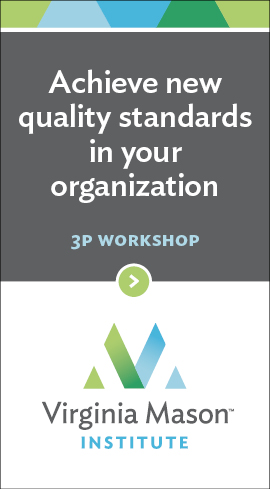By Celeste Derheimer, RN, CPHQ, MBA, Transformation Services Sensei
A culture in support of safety is inextricably linked to a culture where continuous improvement thrives. Leaders drive values, values drive behaviors, and the collective behaviors of the individuals in an organization define its culture. These same leaders must be involved in creating the transformational change that is required to develop and sustain a culture of safety. Then they must implement and maintain a system that continuously engages staff. The Nemawashi gauge is a tool that can help leaders succeed in improving patient safety and engaging staff to contribute to continuous improvement.
Defining the Nemawashi gauge
 Nemawashi is a Japanese term that means “to prepare the soil for planting or transplanting a tree so that it will live,” and it speaks to the adaptive aspects of change. In recent years, Virginia Mason identified five foundational elements needed to support improvement and developed the Nemawashi gauge to assess an area’s readiness for change:
Nemawashi is a Japanese term that means “to prepare the soil for planting or transplanting a tree so that it will live,” and it speaks to the adaptive aspects of change. In recent years, Virginia Mason identified five foundational elements needed to support improvement and developed the Nemawashi gauge to assess an area’s readiness for change:
- 1. Leader preparation
2. Genba presence
3. Daily management
4. Creating a line of sight
5. Staff readiness and engagement
The Nemawashi gauge can help leaders discover the blend of technical and adaptive change required to successfully create and sustain a culture in support of patient safety.
How can leaders use the Nemawashi gauge to engage their staff?
To create and support an improvement culture, leaders and staff need to define the problems and participate in solving them. It’s just as important to move beyond complaints and generate new ideas. With these points in mind, readers can engage staff in the following ways:
- Encourage your staff to speak up, and then reinforce that message. If a staff member believes that there is a process or an obstacle creating a barrier to patient care, the team needs to know. Also let staff know that you would like them to come to work with ideas for improvement, and then reinforce this by asking the team for ideas during huddles, genba walks and meetings.
- Now that you have enabled your staff members to speak up about problems and new ideas, be sure to allow and reward courageousness. Staff need to know that their ideas are important, and that it is OK to feel vulnerable and take chances.
- Be sure that the people who do the work improve the work. Let it be clear that an idea won’t languish in a suggestion box, waiting for someone else to act on it. Ideas need to be tested by the staff who will potentially implement the new ideas in their daily work.
- Support staff as they test their ideas. Check in with them at the genba as part of daily management. Create a line of sight at weekly huddles, too, so staff can report on their progress to the team.
- Remember that staff who see their ideas implemented become more engaged and more likely to continuously generate more ideas. Engaged staff are the ones who regularly seek improvement and make your organization better and your patients safer.
How has the Nemawashi gauge been received at Virginia Mason and other organizations?
At Virginia Mason, the Nemawashi gauge has helped leaders assess the readiness of their teams for change. As a result of using this tool and other patient safety tools and methods, we have seen a steady increase in continuous improvement, especially in clinical engagement. Most notably, we have seen an increase in our staff’s reporting of safety concerns—in fact, our Patient Safety Alerts (which are part of our system for empowering all team members to report any perceived threat to patient safety) have increased significantly because staff are paying close attention and feel empowered to speak up.
In my work as sensei at organizations worldwide, I know that daily management is crucial to sustaining the improvement culture, so I reinforce the constancy of purpose with every leader. At Virginia Mason, we know from our years of experience that discipline is necessary, even with all the other competing priorities and the surprises that come our way in health care. We also know that the resulting culture of engaged staff—and improvement of patient safety—is worth the effort.
To learn more about the Nemawashi gauge and other ways to improve patient safety, register for our course Creating a Culture of Patient Safety.
To learn more about how leaders can create and sustain an improvement culture, register for our course Engaging Staff to Drive Improvement.
 Celeste Derheimer, RN, CPHQ, MBA, is a Transformation Services sensei at Virginia Mason Institute. A Kaizen Fellow graduate, with certification in the Virginia Mason Production System, she has led multiple kaizen activities to improve safety, quality and administrative processes. Prior to joining Virginia Mason Institute, she served as administrative director for Corporate Quality and Safety at Virginia Mason, where she was responsible for organization-wide quality improvement and patient safety. She has held leadership positions in numerous health systems in Washington and Oregon and has served as an examiner for the Malcolm Baldrige National Quality Award since 2006.
Celeste Derheimer, RN, CPHQ, MBA, is a Transformation Services sensei at Virginia Mason Institute. A Kaizen Fellow graduate, with certification in the Virginia Mason Production System, she has led multiple kaizen activities to improve safety, quality and administrative processes. Prior to joining Virginia Mason Institute, she served as administrative director for Corporate Quality and Safety at Virginia Mason, where she was responsible for organization-wide quality improvement and patient safety. She has held leadership positions in numerous health systems in Washington and Oregon and has served as an examiner for the Malcolm Baldrige National Quality Award since 2006.



